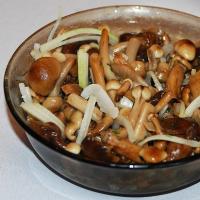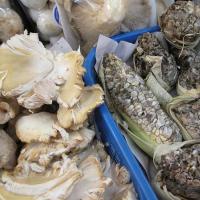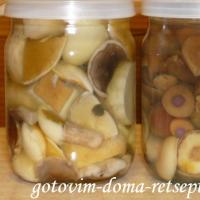Pale grebe - how not to be poisoned by deadly poison
Along with botulism, mushroom food poisoning is the most terrible type of toxic damage, which in 90 cases out of 100 ends in death. Paradoxically, the most common intoxication among them is poisoning with a pale grebe, from which experienced mushroom pickers, their relatives, or people who bought mushrooms from their hands mostly die.
It would seem, how can you confuse this poisonous mushroom with edible species? Why do statistics show such a high mortality rate? What is the difference between champignon and pale grebe, and what you need to know and how to act so that the mushroom dishes eaten do not turn out to be the last food in life?
Appearance of a pale grebe
In fact, it is quite easy to distinguish a pale grebe from other false, not poisonous, but inedible or edible mushrooms. This fungus has certain signs, by the combination of which it is easy to recognize it:
- The hat of a young mushroom is white-gray in color, “wraps around” the leg and, together with it, is in the Volvo film;
- The hat of a mature or old pale grebe is prostrate, glossy, with different shades of white. It can be yellowish, olive, gray and greenish tones.
- The leg of the toadstool is white, expands downwards and has two "skirts". One is located under the hat, and the second wraps around the wide tuber-like extension of the leg. By the way, greenfinches, rows and russula do not have such distinctive films.
- The pulp, "skirts" and plates on the underside of the cap of the pale grebe are snow-white.
- The taste and smell of the pale grebe are pleasant. They don't taste like metal. However, don't check it out. Eating these mushrooms means preparing yourself for a certain painful death.
Attention! You can also get poisoned by microscopic spores of the pale toadstool, which are carried by the wind to a distance of up to 5 m. Therefore, the mushrooms collected in the forest must be thoroughly washed.
Differences from other mushrooms
- How to distinguish champignon from pale grebe? The champignon differs from the pale toadstool in the absence of a thickening in the lower (underground) part of the stem, and at first the snow-white plates at the cap of the young champignon gradually turn into a rich brown color.
- How to distinguish a pale grebe from a delicious umbrella or dung beetle? Pale grebes do not have the characteristic pink-gray or dark gray scales that spread from the center of the caps to the edges in umbrellas and dung beetles. In addition, the dung beetle has a feature by which it is very easy to identify this delicacy mushroom - the cap of even an old mushroom always seems to “wrap around” the leg.
- Distinguish a conditionally edible pusher or float from a pale grebe it is possible only due to the absence of a ring-skirt, therefore only a few experienced mushroom pickers collect such mushrooms, but he is also at risk, since the pusher and pale grebe like to grow mixed. Moreover, floats and grebes may not differ from each other, since the latter sometimes lack a "skirt".
So why is it so easy to get poisoned by pale grebe mushroom? The reason for this is banal inattention or fatigue, especially if the collection takes place in a clearing with a number of growing myceliums of different genera of fungi.
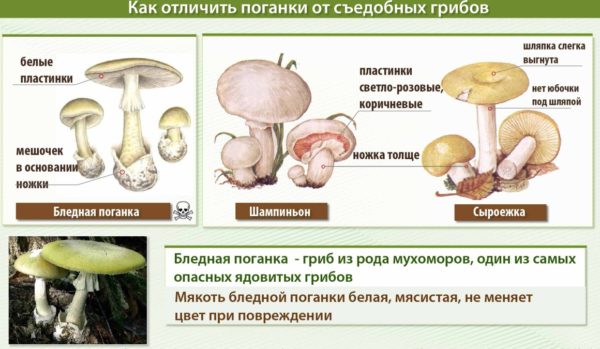
Pale toadstool poison and its effect on the human body
Pale grebe belongs to the most dangerous group of poisonous mushrooms, which have a pronounced plasma toxic effect, which is provided by the content of the following toxins:
- Amanites (α, β, γ, σ). Their action is extended in time, but it is their high concentration that is fatal to humans.
- Phalloidins. A total of 5 varieties have been identified, of which only one decomposes when boiled. These toxins act quickly. Unlike Amish, they do not pose a clear lethal threat, but can lead to disability.
- Amanin. A particularly toxic peptide that affects liver and kidney cells.
The poisons of the pale grebe do not decompose under the influence of vinegar and alcohol, are resistant to high temperatures during boiling, frying, drying, are not afraid of solar radiation, and also withstand deep freezing. In total, 10 varieties of toxins have been isolated from the pale grebe, but only the above have been studied. However, they are more than enough.
For a person weighing about 70 kg, the lethal dose is 0.02-0.03 g, which is contained in only 0.15 g of pale grebes!
These poisons, once in the body, have a certain effect on various systems and organs:
- violate the vital functions of the central nervous system and cause mental abnormalities;
- lead to fatty degeneration of the tissues of the liver, pancreas, spleen and kidneys;
- provoke internal hemorrhages and subsequent tissue necrosis in the walls of the stomach and intestines;
- disrupt metabolism and cause cerebral edema.
An encouraging discovery! Recently, a unique substance, antamanin, has been isolated in the pale grebe, which significantly reduces the toxic effect of α-amanit and phalloidins. Scientists hope that this cyclopeptide will become the basis of a cure for the poisons of the pale toadstool and other poisonous mushrooms.
Symptoms and stages of poisoning
The first signs of poisoning do not appear immediately - the latent period is individual for each organism and ranges from 8 hours to 2 days, but symptoms may appear earlier.
A person who has eaten a pale toadstool does not immediately notice any ailments. The manifestation of symptoms begins only when toxins begin to affect the nerve centers of the brain, which regulate the functions of individual organs.
Symptoms of toadstool poisoning will be expressed in the following order:
- uncontrollable bouts of vomiting;
- after 2-3 hours, fetid diarrhea joins (stools up to 25 times a day), which is accompanied by sharp pains in the abdomen;
- sweating increases sharply;
- in severe poisoning, loss of vision and voice is possible;
- body temperature drops to 35 ° C, limbs become cold, the skin becomes cyanotic;
- dehydration of the body and impaired absorption of nutrients in the small intestine lead to thickening of the blood, unquenchable thirst, cyanosis of the lips and nails, muscle cramps;
- blood pressure drops, the pulse is poorly palpable.
Pale toadstool poisoning occurs in several stages:
- Latent period - usually lasts 6-12 hours, without any symptoms.
- Acute manifestation of symptoms within 1-2 days.
- Stage of imaginary recovery. The symptoms are subsiding. Last about 24 hours. Most often, it is at the end of these days, if treatment in a hospital has not been carried out, death occurs.
- Destruction of the body. If the poisoned person was able to survive the critical moment of the stage of imaginary recovery, then the primary symptoms return. Signs of destruction of the liver and kidneys begin to appear, persistent disturbances in the functioning of the heart muscle occur. All these changes can also be fatal.
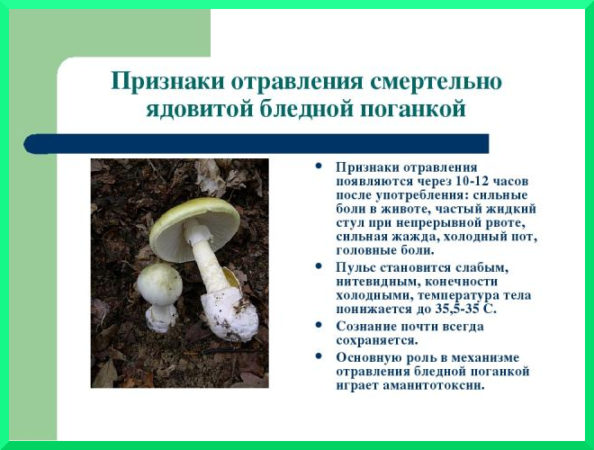
First aid at home
If there is a suspicion of mushroom poisoning, namely, if vomiting begins a few hours after eating mushroom dishes, you should not hesitate and rely on "maybe it will pass by itself."
If you have been poisoned by mushrooms, you should not panic, you must immediately call an ambulance, and while she is traveling, you should wash your stomach. How to properly carry out such a procedure can be found.
After each gastric lavage, a saline laxative should be given. It is good to put an enema - 1.2-1.5 liters is enough for an adult, 0.25 liters of cool water for a child. With convulsions, hot heating pads or mustard plasters are applied to the calves. In case of loss of consciousness, care should be taken that the person does not choke on vomit.
The remains of the mushroom dish and vomit must be transferred to the ambulance doctor for laboratory analysis. This will significantly reduce the time to determine the exact cause of poisoning and help to start appropriate therapy faster.
Treatment for poisoning in a hospital
The decision on hospitalization for treatment for mushroom poisoning is within the competence of the emergency doctor. The following activities will take place in the hospital:
- combating dehydration with the help of droppers with glucose and saline, which are placed according to a special scheme;
- maintaining the central nervous system and cardiac activity with droppers with strychnine nitrate;
- complex intake of teoctic acid, abiocin, ercefurin and ascorbic acid;
- prescribing drugs according to indications - Pantopon, Corazal, morphine.
Prevention of intoxication with pale toadstool
Pale grebe poisoning has its seasonal peak - most often this diagnosis is fixed in August. So if you really want to taste forest mushrooms, then buy them in early summer or autumn. When hunting for mushrooms, and cutting off a fungus that looks like a pale grebe, it is best to throw it away than to look for distinguishing features.
This is interesting. German scientists proposed to use the pale grebe for peaceful purposes, namely, to use its unique ability to concentrate salts of heavy metals to cleanse polluted soils.
In order not to be poisoned by pale toadstools, namely, not to accidentally eat them, there are two most effective ways. Firstly, you should not buy any, especially canned mushrooms from your hands! After all, the toxins of the pale toadstool can be transferred with a mushroom picker's knife to the legs of edible mushrooms. Poisonous toadstool spores present on other mushrooms can also cause poisoning. Secondly, when picking mushrooms, you should remember the golden rule of the mushroom picker: If in doubt, don't take it!

